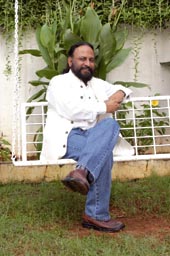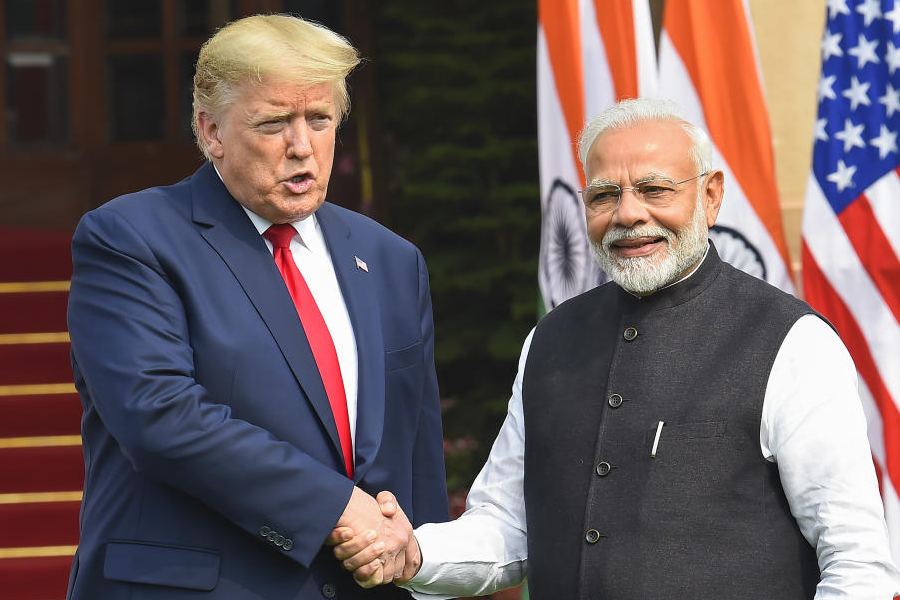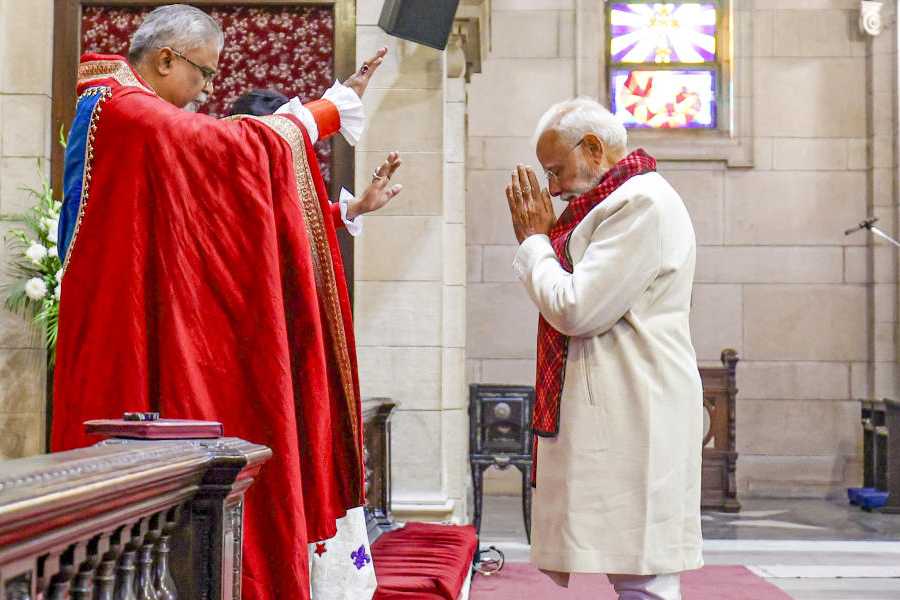 |
| Photo: Sanjit Kundu |
After The Rising, came The Silence. For a brief while, reticence was Ketan Mehta’s answer to the various controversies that the movie seemed to walk into, soon after its release. First it was those who claimed to be the descendants of Mangal Pandey slapping a case against the filmmaker for portraying Pandey in what they claimed was a bad light. Then, it was the flogging from critics for the portrayal of characters in the movie. And finally came the lamming from historians who saw the film as one full of inaccuracies. “The Rising is a past issue now, I’d rather talk about my new projects,” was Mehta’s reply when contacted a couple of weeks after the movie was released.
So after the dust seems to have settled down, has the 55-year-old filmmaker finally put the film behind him? Turns out that the answer is a yes ? and a no. Mehta is currently busy making a sequel to The Rising, his most ambitious project so far. In fact, he’s just returned from a trip to London where he wrapped up auditions for the parts of Britishers in his new movie.
Mangal Pandey was the spark that set off the 1857 Mutiny; the sequels will trace its progression and revolve around characters such as Rani Laxmibai and Emperor Bahadur Shah Zafar. “The Rising, as I saw it, was supposed to be a trilogy,” he says.
The film, for Mehta, has been nothing short of a long awaited dream come true. The filmmaker had envisaged the movie as early as the 1980s, with none other than Amitabh Bachchan in the lead role. Why didn’t the vision take off? Now that’s a 20-year-old skeleton in the closet that Mehta is not very happy about bringing out. For a moment, his face shows reluctance, instantly replaced by an obvious effort to take the question by the horns. Which he does.
“Let’s just say the film was too early for the times. The overseas market was hardly developed then,” he says. And even then, he adds, it was meant to be a big-budget film with a heavy-duty star cast. “It would have been a huge risk considering the odds.”
Also, Mehta could not have taken a risk with his pet commercial project after all. “His sensibility as a filmmaker is more inclined to making meaningful cinema and not the commercial fare he’s churned out in the past few years,” says an actor who’s worked with him before. In that sense, film observers note, he had a lot to finetune once he switched to commercial cinema in the 1990s. That switch, as it turns out, raised many an eyebrow.
After all, a director whose films could win rare plaudits from none other than Satyajit Ray was not expected to start thinking commercial. “Yes, after a while I did start thinking on a larger scale. There was a need to reach out to more and more people through my cinema,” explains Mehta.
Even if the wider reach brings more flak, Mehta has his eyes firmly set on the box office now. What helps, say industry insiders, is wife Deepa Sahi’s business acumen. Says one, “She’s the driving force behind his box office ambition.”
A few years after his marriage to Deepa, whom Ketan had known since her National School of Drama days, Mehta floated his own production house, Maya Entertainment. Since then, Mehta has produced various television serials and a few telefilms along with his feature films. And the ambition has only grown. Deepa too is currently working on a script and hopes to direct her own film soon.
Can their ambitions co-exist? “Deepa and Ketan are a great example of how a couple can not only be friends but also complement each other professionally,” says filmmaker and close friend Sudhir Mishra.
At first glance, the interiors of Mehta’s office could pass off as a corporate executive’s cabin (except for a couple of Mehta’s film posters). And that somewhat contradicts its location ? Maya Entertainment operates out of a cosy bungalow with a small lawn snuggled between a row of houses in the residential area of Mumbai’s Lokhandwala Complex ? and, of course, Mehta’s pony tail.
Downstairs, producers, assistants and crew people scurry around, going about their work. But upstairs in Mehta’s cabin, the atmosphere is a little more formal and businesslike. So is his conduct.
And that, say some acquaintances, is a far cry from the Ketan Mehta of the early days. “I remember Ketan as a person who could only think about making films and nothing else,” says actress Deepti Naval. “Left to himself he would have rather made only films and films that he believed in,” says another friend.
But while some believe that Mehta, like any filmmaker who’s discovering a new medium, needs time to get the commercial formula right, film critics are not as supportive. “His films don’t generate interest at the box office. No one goes to watch a Ketan Mehta masala flick with the same interest as they might have shown in his earlier films such as Mirch Masala,” says a trade analyst. With Mangal Pandey as his only big commercial success (the film recovered its costs within a month of release), critics still need some convincing.
But that’s something Mehta is not unfamiliar with. Years ago, he had to go through a lot of convincing when he decided to plunge into theatre as a career. Born in a Gandhian family in a small town in Gujarat, Mehta’s childhood was spent in Delhi where he graduated from St Stephen’s College. Theatre as a career was something unheard of in the academically-oriented Mehta family. “It took a while for me to convince them. It wasn’t easy. Things settled down a bit when I got admission to the Film and Television Institute of India,” recalls Mehta.
Ironically, it was Mehta’s father who introduced him to Gujarati folk theatre in his childhood. One of Mehta’s strongest childhood memories is of being led by the finger to watch a Gujarati play. Theatre caught Mehta’s fancy and he went on to act in and later direct many plays. So fascinated was he by traditional and folk theatre such as Bhavai, a traditional form of Gujarati folk art and theatre, that his first feature film Bhavni Bhavai (1980) was inspired by a Bhavai folk tale.
His second film Mirch Masala, like his first one, was an earthy tale, set in Rajasthan. The story of an entire village dragged into the struggle of a beautiful village woman who refused to give in to the whims of a despotic subedar won rare acclaim at international film festivals too, where it was released as Spices. He broke away from his penchant for folklore with Maya Memsaab (1992) which was the Flaubertian story of a beautiful but unconventional woman, Maya, trying to escape the drudgery of marriage to a simpleton country doctor.
That was also the first of the three films in which he cast his wife ? and a turning point in his career. His decision to cast Deepa was not taken too well by many colleagues, who accused Mehta of making films only for his wife. “People forget that I was also making Sardar ? without Deepa ? at the time of Maya Memsaab,” is all he’s willing to say. No denial, no justification.
Even when the topic of his first marriage to costume designer Rachna comes up, there is little that he says. While Rachna was based in Ahmedabad, Mehta had a growing reason to settle in Mumbai as post- production facilities were not available in Gujarat. “We were two people driven by different professions. The distance factor also had a lot to do with it, and we drifted apart amicably,” he says.
Denial and defensiveness, clearly, are traits that don’t belong to Ketan Mehta. “He’s his own person, unaffected by what people think or say,” says Naval. That explains the quiet demeanour and uncanny habit of answering in short sentences. The man of few words seems to have even fewer worldly vices. “I don’t think even Ketan himself is really acquainted with his ugly side,” laughs Naval. A moderate social drinker, Mehta is not even a foodie and is known to be a light eater.
Yet controversy seems to dog him faithfully. “I’m used to it,” he says. And as the scale of his films has expanded, so have the controversies, he quips. “That’s the price you pay for what you believe in,” he says. Or is that the price for being Ketan Mehta?











